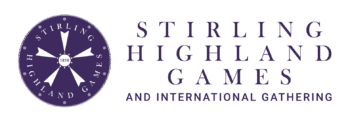The history of the Stirling Highland Games is intrinsically entwined with that of Stirling Castle. The castle goes back to at least the 12th century. Its prominent defensive position was strengthened and altered over the following centuries, with new buildings and fortifications being built.
Given its natural commanding location, close to where the River Forth was bridged, the castle affords panoramic views across the area and controls the routes north and south.
Stirling Castle soon caught the attention of royalty and became a favourite royal residence and administrative centre. During the medieval period, the castle, which is associated with King Arthur, held jousting tournaments, accompanied by lavish feasts, music, and dancing. As the settlement around the castle grew, the area became the focus of trading, and regular markets and fairs were held. It has also been the home of a military garrison for centuries. These early competitions and the military training required to compete at them, are the link to the modern Stirling Highland Games.
The mediaeval jousting traditions at Stirling Castle, were carried on by the Guild of Chapmen, who held “Tilting the Ring” competitions at their annual fairs.
In 1707, the town council offered a purse of silver and the Guildry paid for a gold ring, as a prize for the “Tilting the Ring” competitions, which were held at the King’s Park in Stirling. By 1818, foot and horse races also took place. Within six years, putting a 22lb 4oz. ball, hammer throwing, wrestling, tossing the bar and other sports were included in the programme.
In 1850, to keep up their spirits, soldiers from the garrison at Stirling Castle, played football, held running races and a stone putting competition, between their companies.
In 1851, the officers and men of the 79th Regiment of Foot (Cameron Highlanders), while stationed at Stirling Castle, jointly held Highland Games in the burgh. Along with the traditional “Tilting the Ring” competition, the events included, a standing distance leap, running high leap, standing high leap, vaulting with a pole, hop, step and leap, hitch kick, steeple race, a short and a long foot race, a blind race, throwing the stone, highland dancing and bagpipe playing.
In 1858, the soldiers from the garrison in Stirling Castle, held Highland Games at the King’s Park. The events included, a short foot race, running hop, step, and leap, standing hop, step and leap, a hurdle race, putting the ball, running high leap, standing high leap, a long foot race, throwing the hammer, tossing the caber, a short race, a sack race, and a blindfolded wheelbarrow race.
The Argyll and Sutherland Highlanders, who are now based at Stirling Castle, continued the military tradition of holding regimental Highland Games and Sports.
